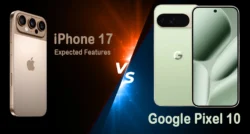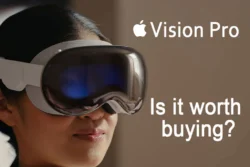The U.S. smartphone market is one of the most competitive and lucrative in the world, driven by high consumer demand, technological innovation, and a robust mobile ecosystem. As of 2025, the market is dominated by a few key players, with Apple and Samsung leading the pack. This blog provides a detailed analysis of the top mobile companies in the USA, their market shares, key trends, and the factors shaping their success, backed by recent data and analytics.
Overview of the U.S. Smartphone Market
The U.S. smartphone market is characterized by high penetration rates, with 90% of adults owning a smartphone as of 2024, up from 35% in 2011. Smartphone shipments in the U.S. are influenced by consumer preferences for premium devices, carrier financing options, and rapid adoption of technologies like 5G and generative AI (GenAI). In Q1 2025, U.S. smartphone shipments grew by 9% year-over-year (YoY), driven by manufacturers stockpiling to circumvent potential tariff impacts. However, economic uncertainties and potential tariffs may lead to a slight market decline for the full year 2025.
The market is heavily concentrated, with Apple and Samsung commanding over 80% of the market share. Emerging brands like Motorola, Google, and Xiaomi are gaining traction, but they face challenges competing against the established duopoly. Below, we dive into the top mobile companies, their market shares, and the strategies driving their performance.
Top Mobile Companies in the USA by Market Share (Q1 2025)
Based on the latest data from sources like Counterpoint Research, Statista, and BankMyCell, here is a breakdown of the top mobile companies in the USA by smartphone market share as of Q1 2025:
- Apple: 57.39% Market Share
- Overview: Apple continues to dominate the U.S. smartphone market, with iPhones accounting for over half of all devices in use. The iPhone 16 series, including the iPhone 16e, drove a 12% YoY shipment growth in Q1 2025, marking Apple’s first-ever Q1 leadership globally.
- Key Drivers:
- Premiumization: The iPhone 16 Pro and Pro Max models saw 11% higher shipments compared to their predecessors, reflecting strong demand for high-end devices.
- Ecosystem Lock-in: Apple’s seamless integration across iOS, macOS, and services like iCloud and Apple Music retains loyal customers.
- Carrier Subsidies: Financing plans from carriers like Verizon, T-Mobile, and AT&T make iPhones more accessible.
- Challenges: Declining sales in China and Europe, coupled with potential U.S. tariff impacts, could affect future growth.
- Analytics Insight: Apple’s iOS holds a 56.63% OS market share in the U.S., compared to Android’s 43.07%, a trend consistent since 2011. The company’s focus on GenAI features, like Apple Intelligence, has been delayed, impacting Q4 2024 performance.
- Samsung: 23.27% Market Share
- Overview: Samsung is the second-largest player in the U.S., offering a diverse portfolio from budget-friendly Galaxy A-series to premium Galaxy S25 Ultra and foldable Z-series devices. Its market share in Q1 2025 was 18% globally, trailing Apple.
- Key Drivers:
- Product Diversity: The Galaxy S25 series, launched later in Q1 2025, saw double-digit sales growth in March, with the Ultra model gaining popularity.
- AI Integration: Samsung’s focus on AI-powered experiences, including a Gemini Advanced subscription, appeals to tech-savvy consumers.
- Mid-Range Appeal: The Galaxy A36 and A56 models offer affordable AI features, boosting sales in the prepaid segment.
- Challenges: Samsung’s mid-range phones face stiff competition from Motorola and Xiaomi, and its global market share has declined from 24.8% to 18.9% over the past decade.
- Analytics Insight: Samsung’s U.S. market share dropped from 29.87% in Q1 2024 to 23.27% in Q1 2025, reflecting Apple’s growing dominance. However, its foldable devices are gaining traction, with the Z Fold 6 and Z Flip 6 appealing to niche audiences.
- Motorola: 3.50% Market Share
- Overview: Motorola, owned by Lenovo, has carved out a niche in the budget and prepaid segments, with models like the Moto G Play 2024 and the revived RAZR flip phone.
- Key Drivers:
- Affordability: Motorola’s low-cost devices appeal to price-sensitive consumers, especially through carriers like T-Mobile and Verizon.
- Nostalgia Marketing: The RAZR’s modern foldable design leverages brand nostalgia, competing with Samsung’s Z Flip.
- Challenges: Motorola lacks the premium appeal of Apple and Samsung, limiting its growth in the high-end segment.
- Analytics Insight: Motorola’s market share has remained steady at 3.50% since Q1 2024, with growth primarily in the sub-$300 price range.
- Google: 2.40% Market Share
- Overview: Google’s Pixel series, including the Pixel 9, has seen increased shipments due to early launches and strong camera capabilities. Its U.S. market share grew slightly from 2024.
- Key Drivers:
- Photography Excellence: Pixel’s AI-driven post-processing features, like Audio Magic Eraser, attract photography enthusiasts.
- Software Updates: Google’s promise of long-term Android updates enhances device longevity.
- Challenges: Limited brand recognition compared to Apple and Samsung restricts Google’s market penetration.
- Analytics Insight: Google’s market share increased from 2.63% in mid-2024 to 2.40% in Q1 2025, driven by the Pixel 9’s early launch.
- Xiaomi: 1.14% Market Share
- Overview: Xiaomi is an emerging player in the U.S., offering competitive budget and mid-range smartphones. Its global market share is stronger (13.9% in Q1 2025), but U.S. growth is slower due to brand unfamiliarity.
- Key Drivers:
- Value for Money: Devices like the Xiaomi 13T offer flagship-level specs at mid-range prices.
- Retail Expansion: Xiaomi is increasing its presence through online channels and partnerships with carriers.
- Challenges: U.S. consumers’ preference for established brands and concerns over Chinese manufacturers limit Xiaomi’s growth.
- Analytics Insight: Xiaomi’s U.S. market share grew from 1.17% in mid-2024 to 1.14% in Q1 2025, reflecting modest but steady progress.
Other Notable Brands
- LG: 0.89% market share, declining since exiting the smartphone market in 2021.
- OnePlus: 0.70% market share, appealing to tech enthusiasts with devices like the OnePlus 13.
- Huawei: 0.36% market share, severely limited by U.S. trade restrictions.
- Oppo and Vivo: 0.34% and 0.33% market shares, respectively, with minimal U.S. presence due to regulatory challenges.
Key Trends Shaping the U.S. Smartphone Market
- Premiumization Trend:
- Consumers are increasingly opting for premium models, with Apple’s iPhone 16 Pro and Samsung’s Galaxy S25 Ultra driving sales. In 2024, Pro models accounted for over 55 million iPhone shipments globally.
- Analytics: The average smartphone price in the U.S. has risen from $400 in 2013 to $600 in 2024, reflecting demand for high-end devices.
- 5G and GenAI Adoption:
- 5G-enabled smartphones dominate the U.S. market, with all major brands offering 5G support. Low-cost 5G devices from Motorola and Samsung are expanding access.
- GenAI features, like Samsung’s AI-powered experiences and Google’s Audio Magic Eraser, are becoming key differentiators.
- Analytics: Mobile data usage in the U.S. doubled from 6GB per month in 2020 to 12GB in 2023, driven by 5G adoption.
- Carrier Influence:
- Major carriers (Verizon, T-Mobile, AT&T) control significant retail channels, with Verizon leading at 18% unit share and T-Mobile at 15% as of September 2023.
- Financing plans and subsidies make premium devices more affordable, boosting Apple and Samsung sales.
- Analytics: T-Mobile and AT&T tied for the highest close rate (89%) among retailers in 2023, indicating strong conversion of store visitors to buyers.
- Foldable Devices:
- Foldable smartphones, led by Samsung’s Z Fold 6 and Z Flip 6, are gaining niche popularity. Motorola’s RAZR also contributes to this trend.
- Analytics: Foldable device sales in the U.S. grew by 20% YoY in 2024, though they represent less than 5% of total smartphone sales.
- App Ecosystem Growth:
- The average U.S. adult spends over 4 hours daily on mobile apps, driving demand for high-performance smartphones.
- Apple’s App Store (1.9 million apps) and Google Play Store dominate, with iOS commanding 58% of U.S. web usage among smartphones.
Analytics: Market Share Trends (2016–2025)
| Year | Apple | Samsung | Motorola | Xiaomi | Others | |
|---|---|---|---|---|---|---|
| 2016 | 45% | 25% | 5% | 1% | 0% | 24% |
| 2020 | 50% | 24% | 4% | 2% | 0.5% | 19.5% |
| 2024 | 61.26% | 22.63% | 3.50% | 2.40% | 1.14% | 9.07% |
| 2025 | 57.39% | 23.27% | 3.50% | 2.40% | 1.14% | 8.30% |
Sources: Statista, Counterpoint Research, BankMyCell
- Apple: Peaked at 61.26% in Q1 2024 but slightly declined to 57.39% in Q1 2025 due to global tariff concerns.
- Samsung: Gained slightly from 22.63% in 2024 to 23.27% in 2025, driven by the S25 series launch.
- Motorola and Google: Stable market shares, with Google showing modest growth due to Pixel 9.
- Xiaomi: Slow but steady growth, constrained by brand awareness.
- Others: Declining share as the market consolidates around top brands.
Consumer Behavior and Demographics
- Ownership: 98% of U.S. adults own a cellphone, with 91% owning smartphones. Those aged 65+ are least likely to own smartphones (78%).
- Usage: Americans spend 4.5 hours daily on mobile phones, checking devices 144 times per day. 57% consider themselves “mobile phone addicts.”
- Loyalty: 18% of iPhone users are former Android users, while 11% of Android users switched from iPhone. User experience (47%) and affordability (29%) drive switches.
- Demographics: iPhone users skew younger and wealthier, while Android users are more diverse in income and age.
Challenges and Opportunities
- Challenges:
- Tariffs: Potential U.S. tariffs on Chinese imports could increase prices, impacting consumer demand.
- Market Saturation: Low upgrade rates and long device lifecycles (3–4 years) slow growth.
- Competition: Emerging brands like Xiaomi face barriers due to consumer preference for Apple and Samsung.
- Opportunities:
- GenAI and Foldables: Innovations in AI and foldable devices offer differentiation.
- Emerging Markets: Brands like Xiaomi can leverage online channels to grow.
- Sustainability: Eco-friendly devices and trade-in programs could attract environmentally conscious consumers.
Conclusion
The U.S. smartphone market in 2025 is a dynamic landscape dominated by Apple (57.39%) and Samsung (23.27%), with Motorola (3.50%), Google (2.40%), and Xiaomi (1.14%) carving out smaller niches. Apple’s ecosystem and premium devices maintain its lead, while Samsung’s diverse portfolio and AI focus keep it competitive. Emerging trends like 5G, GenAI, and foldables, combined with carrier influence and app ecosystem growth, shape the market’s future. However, economic uncertainties and tariffs pose challenges. For consumers and businesses, understanding these dynamics is crucial for navigating this competitive space.
Sources: Counterpoint Research, IDC, Statista, BankMyCell, Pew Research Center, Canalys, Oberlo, ConsumerAffairs







